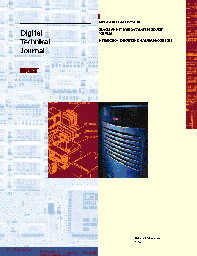|

Jane C. Blake,
Managing Editor
Just 40 years ago, a machine called the TX-0—a successor
to Whirlwind—was built at MIT’s Lincoln Laboratory to
find out, among other things, if a core memory as large as 64
Kwords could be built. Over the years memory sizes have grown so
large that, in the ‘90s, the industry has felt the need to
characterize memory in big machines as very large. At five
orders of magnitude greater in size than the TX-0 memory, the
AlphaServer 4100 8-gigabyte memory is indeed very large, even by
today’s standards. Whole databases can be designed to reside
in memory. Very large memory technology, or VLM, is a key to the
system and application performance discussed in this issue of the
Journal, which features the AlphaServer 4100 system,
database enhancements from Oracle Corporation and from Sybase,
Inc., and extensions to the Alpha architecture.
The AlphaServer 4100 is a midrange, symmetric multiprocessing
system designed for industry-leading performance at a low cost.
The system accommodates up to four 64-bit Alpha 21164
microprocessors operating at 400 megahertz, four 64-bit PCI bus
bridges, and 8 gigabytes of main memory. Opening the section
about the 4100 system, Zarka Cvetanovic and Darrel Donaldson
describe the project team’s performance characterization of
different AlphaServer 4100 models under technical and commercial
workloads. Both the process and the findings are of interest. As
one example set of data demonstrates, the model 5/300 is not only
faster than its DIGITAL predecessors but 30 to 60 percent faster
than a comparative industry platform when running
memory-intensive workloads from the SPECfp95 benchmark.
The four papers that follow examine areas of the system that
challenged designers to keep costs low and at the same time
deliver high performance. The AlphaServer 4100 cached processor
module design is presented by Mo Steinman, George Harris, Andrej
Kocev, Ginny Lamere, and Roger Pannell. Built around the Alpha
21164 64-bit RISC microprocessor, the module is the first from
DIGITAL to employ a high-performance, cost-effective synchronous
cache, the 4-megabyte B-cache, rather than a traditional
asynchronous cache. Next, Roger Dame reviews the clock
distribution system, the use of off-the-shelf phase-locked loop
circuits as the basic building block to keep costs low, and the
signal integrity techniques developed to optimize performance of
the clock distribution system for a worst-case clock skew of 2.2
nanoseconds, a goal which the team far exceeded. A unique memory
architecture for the model 5/300E is the subject of Glenn
Herdeg’s paper. This memory design incorporates a processor
module that has no external cache and instead takes advantage of
the multiple-issue feature of the Alpha 21164 microprocessor.
Closing the section on the 4100 design is the I/O
subsystem’s contribution to the system goals of low memory
latency and high memory and I/O bandwidth. Sam Duncan, Craig
Keefer, and Tom McLaughlin present several innovative techniques
developed for the system bus-to-PCI bus bridge design. These
techniques include partial cache line writes, peer-to-peer
transactions across multiple PCI bridges, and support for large
bursts of data.
All efforts to make the hardware run faster are for the
benefit of the applications that run on those systems. A paper
from Oracle Corporation and another from Sybase, Inc., examine
ways in which their respective database systems take advantage of
VLM. Vipin Gokhale describes the 64 Bit Option implementation for
the Oracle7 relational database system. A primary project goal
was to demonstrate a clear performance benefit for two classes of
database applications: decision support systems and online
transaction processing. The author summarizes data that show a
clear benefit for a database with the 64 Bit Option enabled
running on the AlphaServer 8400 with 8 gigabytes of memory; in
some cases, the performance increase was more than 200 times that
of the standard configuration. Sybase engineers T.K. Rengarajan,
Max Berenson, Ganesan Gopal, Bruce McCready, Sapan Panigrahi,
Srikant Subramaniam, and Marc Sugiyama examine the technology of
the System 11 SQL Server that was specifically designed for VLM
systems. In addition to achieving record results with the SQL
Server design running on the AlphaServer 8400, the engineers have
laid the groundwork for future main memory database systems.
Recently, byte and word instructions were added to
DIGITAL’s 64-bit Alpha architecture and implemented in the
second generation of the Alpha 21164 microprocessor. Dave Hunter
and Eric Betts describe the process of analyzing how these
additions affect the performance of a commercial database. For
testing, the team used prototype hardware, rebuilt Microsoft
Corporation’s SQL Server to use the new instructions, and
ran the TPC-B benchmark.
The editors thank Darrel Donaldson of the AlphaServer 4100
team and Kuk Chung of DIGITAL’s Database Application
Partners group for their efforts to acquire the papers presented
in this issue. Our upcoming issue will be devoted to CMOS-6
process and technologies developed by the DIGITAL Semiconductor
Division.
|
|